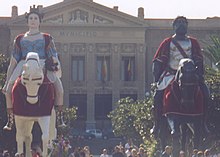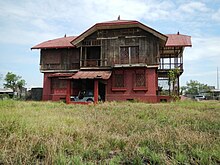Legend
A legend is a genre of
Many legends operate within the realm of uncertainty, never being entirely believed by the participants, but also never being resolutely doubted.
A modern folklorist's professional definition of legend was proposed by Timothy R. Tangherlini in 1990:[5]
Legend, typically, is a short (mono-) episodic, traditional, highly ecotypified[6] historicized narrative performed in a conversational mode, reflecting on a psychological level a symbolic representation of folk belief and collective experiences and serving as a reaffirmation of commonly held values of the group to whose tradition it belongs.
Etymology and origin
Legend is a loanword from Old French that entered English usage c. 1340. The Old French noun legende derives from the Medieval Latin legenda.[7] In its early English-language usage, the word indicated a narrative of an event. The word legendary was originally a noun (introduced in the 1510s) meaning a collection or corpus of legends.[8][9] This word changed to legendry, and legendary became the adjectival form.[8]
By 1613, English-speaking
In 1866,
Compared to the highly structured folktale, legend is comparatively amorphous,
In Einleitung in der Geschichtswissenschaft (1928),
Christian legenda
In a narrow Christian sense, legenda ("things to be read [on a certain day, in church]") were
Oral tradition
History preserved orally through many generations often takes on a more narrative-based or mythological form over time,[26] an example being the oral traditions of the African Great Lakes.
Related concepts

From the moment a legend is retold as fiction, its authentic legendary qualities begin to fade and recede: in
Stories that exceed the boundaries of "
Legend may be transmitted orally, passed on person-to-person, or, in the original sense, through written text.
Urban legend


Urban legends are a modern genre of folklore that is rooted in local
The term "urban legend," as generally used by folklorists, has appeared in print since at least 1968.
See also
- The Matter of Britain, Arthurian legend
- Legendary saga
- Legendary creature
- Lists of legendary creatures
- Narrative history
References
- ISBN 0-253-32934-5.
- ISBN 978-0-19-871544-3. Archivedfrom the original on 2021-04-26. Retrieved 2021-04-24.
A story or group of stories handed down through popular oral tradition, usually consisting of an exaggerated or unreliable account of some actually or possibly historical person—often a saint, monarch, or popular hero. Legends are sometimes distinguished from myths in that they concern human beings rather than gods, and sometimes in that they have some sort of historical basis whereas myths do not; but these distinctions are difficult to maintain consistently. The term was originally applied to accounts of saints' lives..
- ^ Bascom, William Russell (1965). The Forms of Folklore: Prose Narratives. University of California. pp. 4–5, 9.
Myths are often associated with theology and ritual. Their main characters are not usually human beings, but they often have human attributes; they are animals, deities, or culture heroes, whose actions are set in an earlier world, when the earth was different from what it is today, or in another world such as the sky or underworld....Legends are more often secular than sacred, and their principal characters are human. They tell of migrations, wars and victories, deeds of past heroes, chiefs, and kings, and succession in ruling dynasties.
- ^ Norbert Krapf, Beneath the Cherry Sapling: Legends from Franconia (New York: Fordham University Press) 1988, devotes his opening section to distinguishing the genre of legend from other narrative forms, such as fairy tale; he "reiterates the Grimms' definition of legend as a folktale historically grounded", according to Hans Sebald's review in German Studies Review 13.2 (May 1990), p 312.
- ^ Tangherlini, "'It Happened Not Too Far from Here...': A Survey of Legend Theory and Characterization" Western Folklore 49.4 (October 1990:371–390) p. 385.
- ^ That is to say, specifically located in place and time.
- ^ Oxford English Dictionary, s.v. "legend"
- ^ a b Harper, Douglas. "legendary". Online Etymology Dictionary. Retrieved 10 June 2013.
- ^ "legendry". Merriam-Webster.com Dictionary.
- ^ Patrick Collinson. Elizabethans, "Truth and Legend: The Veracity of John Foxe's Book of Martyrs" 2003:151–77, balances the authentic records and rhetorical presentation of Foxe's Acts and Monuments, itself a mighty force of Protestant legend-making. Sherry L. Reames, The Legenda Aurea: a reexamination of its paradoxical history, 1985, examines the "Renaissance verdict" on the Legenda, and its wider influence in skeptical approaches to Catholic hagiography in general.
- ^ Das Märchen ist poetischer, die Sage, historischer, quoted at the commencement of Tangherlini's survey of legend scholarship (Tangherlini 1990:371)
- ^ Wehrhan Die Sage (Leipzig) 1908.
- ^ Ranke, "Grundfragen der Volkssagen Forshung", in Leander Petzoldt (ed.), Vergleichende Sagenforschung 1971:1–20, noted by Tangherlini 1990.
- ^ Peuckert, Sagen (Munich: E Schmidt) 1965.
- ^ This was stimulated in part, Tangherlini suggests, by the 1962 congress of the International Society for Folk Narrative Research.
- ^ Ranke, "Grundfragen der Volkssagenforschung", Niederdeutsche Zeitschrift für Volkskunde 3 (1925, reprinted 1969)
- ^ Charles L. Perdue Jt., reviewing Linda Dégh and Andrew Vászony's essay "The crack on the red goblet or truth and the modern legend" in Richard M. Dorson, ed. Folklore in the Modern World, (The Hague: Mouton 1978), in The Journal of American Folklore 93 No. 369 (July–September 1980:367), remarked on Ranke's definition, criticized in the essay, as a "dead issue". A more recent examination of the balance between oral performance and literal truth at work in legends forms Gillian Bennett's chapter "Legend: Performance and Truth" in Gillian Bennett and Paul Smith, eds. Contemporary Legend (Garland) 1996:17–40.
- ^ de Boor, "Märchenforschung", Zeitschrift für Deutschkunde 42 1928:563–81.
- ^ Lutz Röhrich, Märchen und Wirklichkeit: Eine volkskundliche Untersuchung (Wiesbaden: Steiner Verlag) 1956:9–26.
- ^ Heiske, "Das Märchen ist poetischer, die Sage, historischer: Versuch einer Kritik", Deutschunterricht14 1962:69–75.
- ^ Bernheim, Einleitung in der Geschichtswissenschaft(Berlin: de Gruyter) 1928.
- ^ Allport, The Psychology of Rumor (New York: Holt, Rinehart) 1947:164.
- ^ Bengt af Klintberg, "Folksägner i dag" Fataburen 1976:269–96.
- ^ William Hugh Jansen, "Legend: oral tradition in the modern experience", Folklore Today, A Festschrift for Richard M. Dorson (Bloomington: Indiana University Press) 1972:265–72, noted in Tangherlini 1990:375.
- ^ Literary or Profane Legends Archived 2010-06-11 at the Wayback Machine. Catholic Encyclopedia.
- ^ Vansina, Jan (1985). Oral tradition as history. University of Wisconsin Press.
- ^ Hippolyte Delehaye, The Legends of the Saints: An Introduction to Hagiography (1907) Archived 2010-01-10 at the Wayback Machine, Chapter I: Preliminary Definitions
- ISBN 9781593392932.
- ^ Timothy R. Tangherlini, "'It Happened Not Too Far from Here...': A Survey of Legend Theory and Characterization" Western Folklore 49.4 (October 1990:371–390). A condensed survey with extensive bibliography.
- ^ Oxford English Dictionary, 2d ed. 1989, entry for "urban legend," citing R. M. Dorson in T. P. Coffin, Our Living Traditions, xiv. 166 (1968). See also William B. Edgerton, The Ghost in Search of Help for a Dying Man, Journal of the Folklore Institute, Vol. 5, No. 1. pp. 31, 38, 41 (1968).
